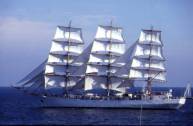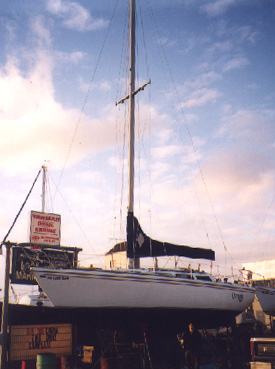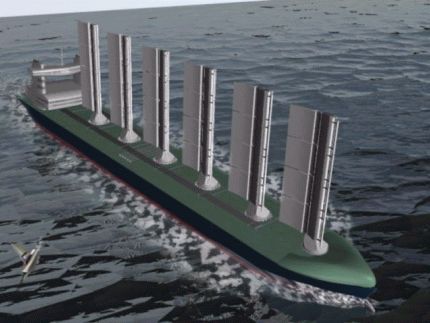|
| |
SAIL TRANSPORT
NETWORK...
Welcome Aboard!
*** Note this is the STN homepage ARCHIVE. The latest STN info is at:
sailtransportnetwork.org ***

Are
the days of tall ships really over?
Civilization has extracted vast resources
of tall trees, such that only 5% remain in many forests such as the Pacific Northwestern American. Yet,
smaller boats of sail and canoe design will still be useful, and employ renewable
energy: the wind.
Through the cultivation of reeds, hemp and other materials and conservation of
trees, sustainable transport and trade will take us well into the new millenniumóas
oil is running out.
RENEWABLE ENERGY = SUSTAINABLE
TRADE!
Sail Transport Network is a movement. For
thousands of years, wind energy moved people and goods all over the
worldówithout pollution. Today, dwindling, geopolitically sensitive oil
is used for every form of transportation and commerce. Even e-commerce
with computers is dependent on forms of petroleum, and trucks and cars clog
roads to a deathly degree.
JOIN THE SAIL TRANSPORT
NETWORK
Sail Transport Network intends to resurrect
renewable-energy travel and freight. STN was begun in 2000 in the Puget
Sound where there are hundreds of harbor-towns and inlets in protected
waters. We present this opportunity to network with sailors who are
cognizant of the role sailboats will once again play in transport in coastal
areas as gas, propane and diesel prices continue to climb according to the law of supply and demand. |
HOW TO JOIN
Membership has various participatory categories and
is free. To help build STN, your time and thoughts are needed as much as
equipment and funds. To join: send an email, or write P.O. Box 3387,
Santa Cruz, CA, 95063 USA, expressing interest in being
part of the appropriate-tech solution to the fuel crunch and global warming. You
will receive a brochure and a free copy of the Sail Transport Network Cover
Issue #17 of the Auto-Free Times (renamed Culture Change as of issue #19;
see article).
Tax-deductible donations to our nonprofit sponsor, Sustainable Energy Institute,
are needed to launch the Sail Transport Network. Loaning a sailboat to STN for
charter gratis can also yield a tax deduction.
Human Power in Venice
 This
picture shows some boats that act as lifelines for the citizens of Venice.
Venice is famous for its gondolas, which work well for traveling on shallow
water, but, in today's "reality," residents travel using motorboatsóthe
always-black gondolas are reserved for tourists. Perhaps in the not so distant
future they will use more wind and sail, and less oil, gas and motors. This
picture shows some boats that act as lifelines for the citizens of Venice.
Venice is famous for its gondolas, which work well for traveling on shallow
water, but, in today's "reality," residents travel using motorboatsóthe
always-black gondolas are reserved for tourists. Perhaps in the not so distant
future they will use more wind and sail, and less oil, gas and motors.
Protect the ocean from
pollution
The Algalita
Marine Research Foundation concerns itself with petroleum damage to the
seas. Plastic in the ocean may be one of the most alarming of
today's environmental stories. Algalita's founder, Charles Moore, went
sailing in the middle of the Pacific and was astounded by all the plastic
debris.
Bluewater
Network protects the sea from fossil fuels pollution. It has campaigns
against cruise ships, a boycott Ford Motor Co. project, and is
fighting ferries polluting 100 to 1,000 times more than cars on a
per-passenger-mile basis. Bluewater's founder, Russell Long, has agreed to
sit on the Advisory Board of Sail Transport Network.
STN's
growth: soon to outpace SUVs
Like it or not,
oil supplies are dwindling and cheap oil is a thing of the past. Oil and
fuel prices are still massively subsidized, guaranteeing disruptive supply
crises within a decade perhaps. There is no time to wait to initiate alternative
transport. STN's sponsors have developed Pedal
Power Produce on land, to deliver food without petroleum.
The Puget Sound is ideally located to serve as home base for the Sail Transport
Network. As fuel will get scarce (see petroleum
analysis) and the ice caps continue to melt (see climate
protection), we
can begin to re-establish sail transport and canoes and kayaks as healthy
alternatives to trucks and motorized shipping in coastal areas and waterways.
The History Behind STN and SEI
The Sustainable Energy Institute was founded in
1988, by Jan Lundberg, who sailed to Europe from California as a teenager.
SEI is
nonprofit, tax-deductible 501(c)(3) corporation, i.e., we are qualified to
accept tax-deductible donations. We publish Culture Change and founded the
Alliance for a Paving Moratorium. Our mission is to reduce dependence on
petroleum and to promote non-motorized modes of transport. STN will serve as an
internationally replicable model for sustainable transport networks in all
coastal areas.
Membership Structure and Annual Support*
Individual/family (sailors, passenger)....
Marina/Port....
Boat Donor...(~tax deduction).
Business Sponsor (marine products/services, food producers, etc.)....
Trading participant (craftspersons, artists, consultants, etc.)...
*may be in the form of barter, trade, or tax deductible donation.
Any additional fees for passage or freight will be determined based on
availability of boats and other factors.
Email interest in STN to receive
brochure and free issue of Culture Change
How to advance Sail Transport by providing a
sailboat, equipment or funds.
Can you spare a sailboat? Do strike a blow for the now
melted North Pole, or the government's blind reliance on oil consumption and
OPEC. Take a tax deduction and boost STN's fleet; see your boat used for freight
and ecotourism by sail.
Instead of selling under pressureóeven at a lossódonate your boat to STN/Sustainable
Energy Institute. Many a stout vessel sits sadly at the dock. Wish to keep
ownership? Loan it to STN for charter, and take a tax deduction.
Founded in 1988 to reduce dependency on oil while lessening pollution,
Sustainable Energy Institute (SEI) has IRS 501(c)(3) tax-deductible
status. STN founder Jan Lundberg, SEI president, has been called "a
visionary" by Associated Press, and "The Oracle" by Chevron. Upon
going green Jan has contributed non-petroleum solutions for transportation and
agriculture. To reach him, email him.

The Odyssey was the Sail Transport Network's first
ship. Now under new ownership and called the Vida, it is still available
for STN demonstration and education.
Modern
Windships: high-tech "sail" transport The
illustration below is from an awesome website's exhaustive study on wind-powered
ships 
Milj¯styrelsen,
a Copenhagen, Denmark group housed at the Danish EPA.
See the link for their study. We have inquired of their design's
requirements for
metals, plastics, batteries, etc. We will update this page when possible.
| |
|